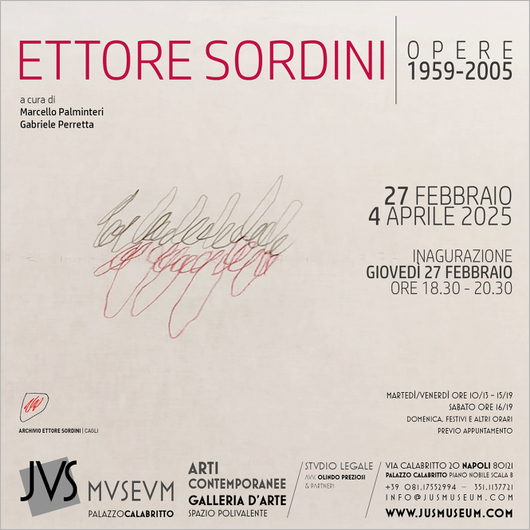
ETTORE SORDINI
WORKS 1959-2005
curated by Marcello Palminteri & Gabriele Perretta
27 FEBRUARY - 4 APRIL 2025
Lucio Fontana, in 1957, when presenting Ettore Sordini's exhibition (with Piero Manzoni and Angelo Verga) pointed out the restlessness of the three young artists and their important contribution to the field of young painting. Together with Piero Manzoni, Sordini drafted numerous manifestos, including ‘Manifesto per una zona di immagini’ (1956), ‘L'Arte non è vera creazione’ (1957), ‘Per una pittura organica’ (1957). In January 1959, he was among the signatories of the ‘Naples Manifesto’. The exhibition at the JUS Museum | Art Gallery displays works from 1959 to 2005, with a particular focus on the sign experiments of the 1960s, and some canvases produced after 2000, testifying to a singular creative parabola. Sordini's painting progressively decants the material value and becomes more and more rarefied in a thin and meagre sign, primary but sinuous; it is for a soft and delicate, almost impalpable colouring. Already in his early works, in fact, a mature sensitivity transpires through a completely original and highly personal graphism.
They are intimately complex sign images that find breath in the pristine, free field of the surface. Sordini makes use of an entirely graphic technique to create sparse and subtle traces of colour on the canvas, sampled in a single tone, that refer to memories of filamentous anthropoid images, so as to arrive at the sign already through a process of zeroing a materiality of existential origin as a conquest of lyrical freedom. In 1962, with Agostino Ferrari, Ugo La Pietra, Angelo Verga and Arturo Vermi and Alberto Lùcia as theorist, he founded the ‘Gruppo Il Cenobio’: an extreme attempt to oppose both the nihilistic and hypercritical tendencies towards painting and the incipient invasion of American artistic culture. The orientation towards the sign, close to the experiments of the Roman group in which Capogrossi, Sanfilippo, Accardi, Novelli, Perilli, Tancredi Parmeggiani and Twombly emerged, set Sordini to act as a bridge between the two situations, the one in Milan and the one in Rome: It was in the capital, in fact, that the artist moved after the dissolution of Cenobio. His attention to the research of the 1960s and 1970s placed Ettore Sordini among the protagonists of numerous exhibitions, including: ‘Linee della ricerca artistica in Italia, 1960-1980’, Palazzo delle Esposizioni, Rome (1981); ‘Il segno della pittura e della scultura’, Palazzo della Permanente, Milan (1983); ‘Pittura-Scrittura-Pittura’ (curated by Filiberto Menna), Erice, Rome, Suzzara (1987); ‘Milano et Mitologia. I poli della ricerca visiva 1958-1964’ (curated by Angela Vettese), Centro Culturale Bellora, Milan (1989); ’Nel segno del segno. Dopo L'Informale’ (curated by Luciano Caramel), Palazzo delle Stelline, Milan (2013); ’1963 e dintorni. New signs, new forms, new images’ (curated by Francesco Tedeschi), Gallerie d'Italia, Milan; “Nati nel ”30. Milan and the generation of Piero Manzoni’ (curated by Elena Pontiggia and Cristina Casero), Palazzo della Permanente, Milan (2014); ’Gruppo del Cenobio. Fontana, Manzoni and the Avant-Garde', Brun Fine Art, London (2019). Recent retrospective, curated by Alberto Mazzacchera, at Polo Culturale Le Clarisse, Grosseto (2023).

